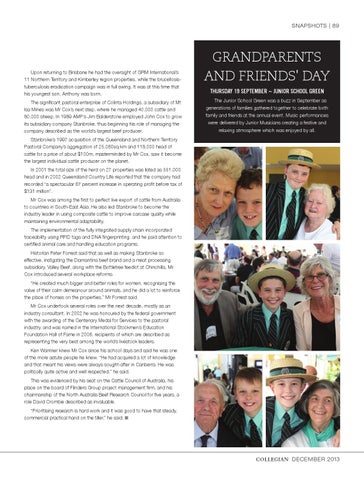SNAPSHOTS | 89
Upon returning to Brisbane he had the oversight of GRM International’s 11 Northern Territory and Kimberley region properties, while the brucellosistuberculosis eradication campaign was in full swing. It was at this time that his youngest son, Anthony was born. The significant pastoral enterprise of Colinta Holdings, a subsidiary of Mt Isa Mines was Mr Cox’s next step, where he managed 40,000 cattle and 80,000 sheep. In 1989 AMP’s Jim Balderstone employed John Cox to grow its subsidiary company Stanbroke, thus beginning his role of managing the company described as the world’s largest beef producer.
GRANDPARENTS AND FRIENDS' DAY THURSDAY 19 SEPTEMBER ~ JUNIOR SCHOOL GREEN The Junior School Green was a buzz in September as generations of families gathered together to celebrate both family and friends at the annual event. Music performances were delivered by Junior Musicians creating a festive and relaxing atmosphere which was enjoyed by all.
Stanbroke’s 1997 acquisition of the Queensland and Northern Territory Pastoral Company’s aggregation of 25,060sq km and 118,000 head of cattle for a price of about $100m, masterminded by Mr Cox, saw it become the largest individual cattle producer on the planet. In 2001 the total size of the herd on 27 properties was listed as 551,000 head and in 2002 Queensland Country Life reported that the company had recorded “a spectacular 67 percent increase in operating profit before tax of $131 million”. Mr Cox was among the first to perfect live export of cattle from Australia to countries in South-East Asia. He also led Stanbroke to become the industry leader in using composite cattle to improve carcase quality while maintaining environmental adaptability. The implementation of the fully integrated supply chain incorporated traceability using RFID tags and DNA fingerprinting, and he paid attention to certified animal care and handling education programs. Historian Peter Forrest said that as well as making Stanbroke so effective, instigating the Diamantina beef brand and a meat processing subsidiary, Valley Beef, along with the Bottletree feedlot at Chinchilla, Mr Cox introduced several workplace reforms. “He created much bigger and better roles for women, recognising the value of their calm demeanour around animals, and he did a lot to reinforce the place of horses on the properties,” Mr Forrest said. Mr Cox undertook several roles over the next decade, mostly as an industry consultant. In 2002 he was honoured by the federal government with the awarding of the Centenary Medal for Services to the pastoral industry, and was named in the International Stockmen’s Education Foundation Hall of Fame in 2006, recipients of which are described as representing the very best among the world’s livestock leaders. Ken Warriner knew Mr Cox since his school days and said he was one of the more astute people he knew. “He had acquired a lot of knowledge and that meant his views were always sought-after in Canberra. He was politically quite active and well respected,” he said. This was evidenced by his seat on the Cattle Council of Australia, his place on the board of Flinders Group project management firm, and his chairmanship of the North Australia Beef Research Council for five years, a role David Crombie described as invaluable. “Prioritising research is hard work and it was good to have that steady, commercial practical hand on the tiller,” he said.
COLLEGIAN COLLEGIAN DECEMBER AUGUST 2013
